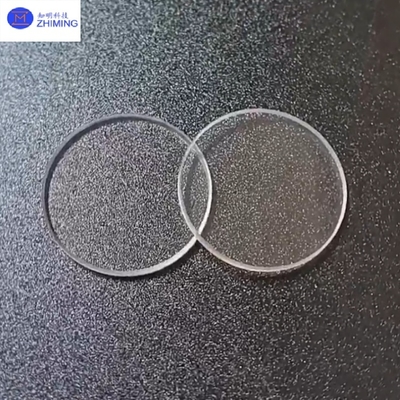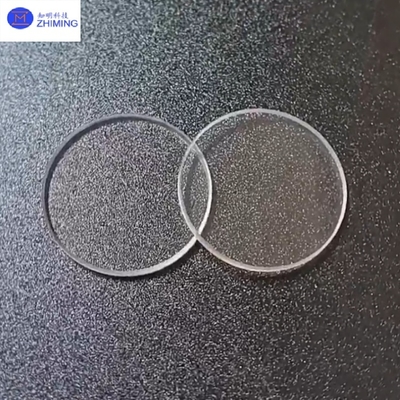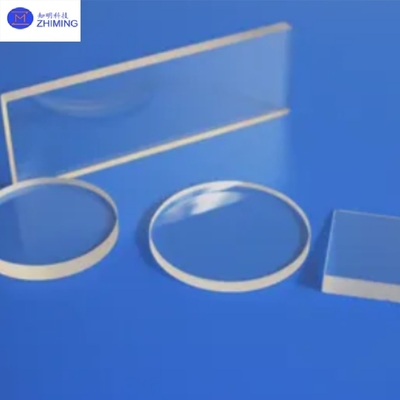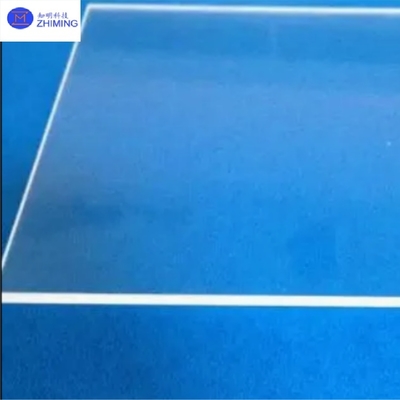JGS1/JGS2/JGS3 Transparent UV Fused Silica Radiation Shielding Windows
Quartz glass, particularly JGS1, JGS2, and JGS3, is an amorphous material synthesized from high-purity silicon dioxide (SiO₂ ≥ 99.99%) via hydroxy flame melting or electric fusion. Its core characteristics include:
- Optical Performance: Broad spectral transmission ranging from ultraviolet (185 nm) to mid-infrared (3.5 μm), with visible light average transmittance >90%.
- Thermal Stability: Thermal expansion coefficient as low as 5.5×10⁻⁷/°C (20–320°C), softening point at 1683°C, and operational stability at 1100°C for prolonged periods.
- Chemical Inertness: Resistant to all strong acids except hydrofluoric acid, and 30× more alkali-resistant than ceramics and 150× more than stainless steel.
JGS1/JGS2/JGS3 Fused Silica Characteristic

1. JGS1: Far-Ultraviolet Optical Fused Silica
- Transmission Range: 185–2500 nm, with >85% transmittance at 185 nm (no absorption peaks).
- Hydroxyl (OH) Content: 2000 ppm (synthesis-based), fluorescence-free, ideal for precision UV optical systems.
- Birefringence: <2 nm/cm, superior to conventional optical glass.
- Semiconductor Lithography: Substrate for EUV lithography mirrors to minimize UV scattering.
- Quantum Communication: Window material for single-photon detectors to reduce photon loss.
2. JGS2: Ultraviolet Optical Fused Silica
- Transmission Range: 220–2500 nm, with a hydroxyl absorption peak at 2730 nm (OH content: 100–200 ppm).
- Fluorescence: Emits visible light under 254 nm excitation; avoid intense UV exposure.
- Mechanical Strength: Compressive strength of 1.14 GPa, exceeding JGS1’s 0.7 GPa.
- Laser Machining: Window for 1064 nm fiber laser cutting heads, enduring >10⁶ W/cm² power density.
- High-Temperature Monitoring: Industrial furnace observation windows resisting 1450°C thermal shock.

3. JGS3: Infrared Optical Fused Silica
- Transmission Range: 260–3500 nm, >85% transmittance at 3.5 μm (OH content <5 ppm).
- Impurity Control: Metal impurities ≤50 ppm (Fe, Ti), bubble density <5/cm².
- Thermal Conductivity: 1.4 W/(m·K), outperforming JGS2’s 1.38 W/(m·K).
- Aerospace Thermal Imaging: Satellite IR sensor windows resistant to cosmic-ray-induced fluorescence.
- Medical Lasers: Lenses for CO₂ laser therapy systems to mitigate thermal lensing.
JGS1/JGS2/JGS3 Fused Silica Key Features
- Broad Spectral Transmission: Full-waveband transmission from 185 nm (JGS1) to 3.5 μm (JGS3), with >90% average visible transmittance.
- Laser Damage Resistance: JGS1’s damage threshold >10 J/cm² (1064 nm, 10 ns pulse).
- Extreme Temperature Tolerance: Short-term use up to 1300°C (JGS1), long-term stability at 1100°C.
- Chemical Resistance: HF etching rate <0.1 μm/h (JGS1), superior alkaline stability (pH >12).
Fused Silica Glasses JGS1, JGS2, JGS3 Physical Properties
| Parameter |
JGS1 |
JGS2 |
JGS3 |
| Maximum size |
<200 mm |
<300 mm |
<200 mm |
| OH content |
1200 ppm |
150 ppm |
5 ppm |
| Fluorescence (excited at 254nm) |
Almost none |
Strong V-b |
Strong V-b |
| Impurity content |
5 ppm |
20–40 ppm |
40–50 ppm |
| Birefringence Constant |
2–4 nm/cm |
4–6 nm/cm |
4–10 nm/cm |
| Melting method |
Synthetic CVD |
Oxy-hydrogen melting |
Electric melting |
| Applications |
Laser substrates, windows, lenses, prisms, mirrors |
Semiconductor and high-temperature windows |
Infrared and ultraviolet substrates
|
Fused Silica Glasses JGS1, JGS2, JGS3 Applications
1. Laser Substrates:
- JGS1: High-power laser resonator mirrors to suppress thermal wavefront distortion.
- JGS2: Fiber laser cutting head windows.
2. Semiconductor Manufacturing:
- JGS2: Wafer defect inspection UV source windows.
- JGS3: Lithography machine UV transmission components.
3. High-Temperature Windows:
- JGS1: Aerospace thermal protection system observation windows.
- JGS3: Molten metal temperature monitoring systems.
4. IR/UV Components:
- JGS3: Quantum communication single-photon detectors.
- JGS1: Deep-UV laser resonator mirrors.
Fused Silica Glasses JGS1, JGS2, JGS3 Processing & Treatment

1. Cutting:
- Laser Cutting: JGS1 ultra-thin sheets (<0.5 mm) with ±1 μm precision; JGS3 large plates (>200 mm) to avoid thermal stress cracks.
2. Surface Treatment:
- Chemical Polishing: JGS1 refractive index uniformity <λ/20 (λ=632.8 nm); JGS3 anti-reflective coatings (e.g., MgF₂, >99.5% transmittance at 200–2500 nm).
3. Thermal Treatment:
- Annealing: JGS1 annealed at 1215°C for 2 hours to eliminate stress birefringence; JGS3 vacuum annealing to reduce bubble density.
Fused Silica Glasses JGS1, JGS2, JGS3 Q&A
1. Q: What are the key differences between JGS1, JGS2, and JGS3 quartz glass?
A: JGS1 (185-2500nm) is optimized for deep UV, JGS2 (220-2500nm) for standard UV, and JGS3 (260-3500nm) for infrared, with distinct hydroxyl content and impurity levels.
2. Q: Which industries use JGS3 quartz glass?
A: Semiconductor lithography, aerospace infrared sensors, and biomedical imaging due to its high IR transmittance (>85%).
Tag: #Optical Fused Silica Glasses, #Customized, #JGS1/JGS2/JGS3, #Transparent UV Grade, #Fused Silica, # Radiation Shielding Windows

 Por favor verifique seu email!
Por favor verifique seu email! Por favor verifique seu email!
Por favor verifique seu email!  Por favor verifique seu email!
Por favor verifique seu email! Por favor verifique seu email!
Por favor verifique seu email! 



